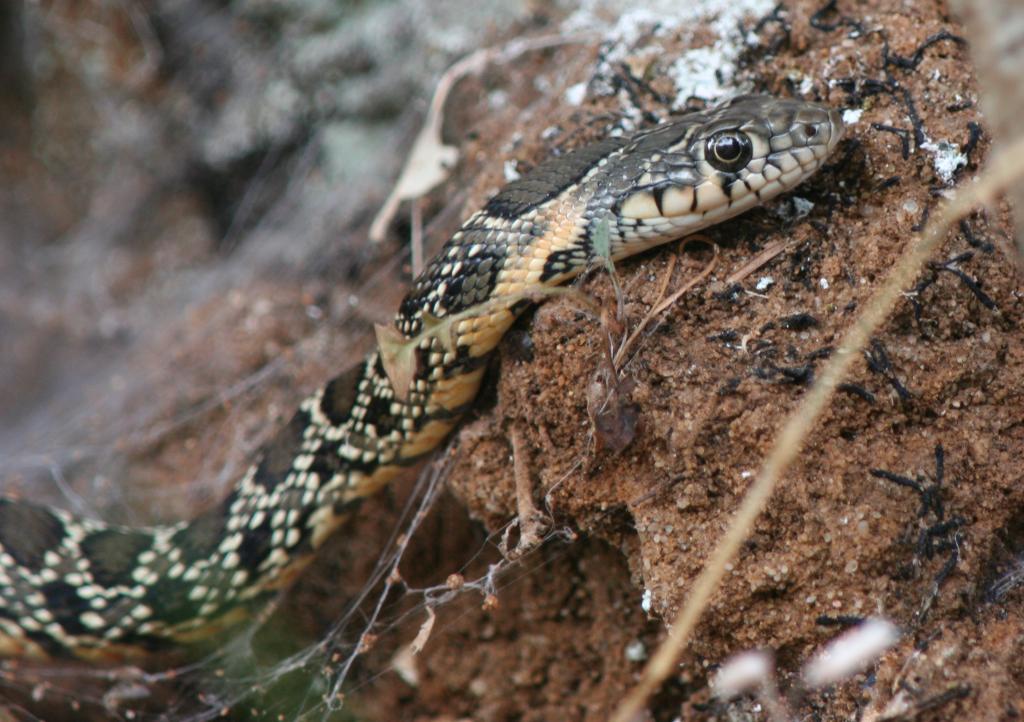Non-Venomous
- English: Horseshoe Whip Snake.
- Scientific: Hemorrhois hippocrepis (
Coluber hippocrepis(Linnaeus 1758). - Castilian: Culebra herradura.
- Catalan: Serp de ferradura.
- Portuguese: cobra-do-ferradura.
- Family: Colubridae.
- Distribution: Found in Algeria, Morocco and Tunisia in North Africa, and in southern and central Portugal, southern, eastern and central Spain, Gibraltar, southern Sardinia and Pantelleria Island in Europe. In the island locations, it may have been introduced. Since the early 2000s it has been reported from Balearic Islands of Mallorca, Ibiza and Formentor. (It could have been introduced there by way of old olive trees imported from mainland Spain).
The Horse-shoe whip snake can reach a length of 180cm although they are often less. They are fairly slender, shy and fast moving. Although mostly diurnal they can also be seen out on warm evenings (crepiscular).

The body pattern is brighter and more obvious on juveniles with the main colour varying between yellow, off white, olive, grey or sometimes brown, this is marked by large black or brown spots uniformly placed along the dorsal line with smaller alternating spots along the flanks. In adults the paler areas within the pattern are much finer giving an overall darker appearance. (Sometimes very dark almost black). The belly is pale in shades of peach, yellow, orange or red with dark marks openly dispersed near the head and more dense near the tail. The name stems from a shape on the head which looks like a horse shoe with the points facing back.

Their habitat ranges from coastal plains with low vegetation to dry scrub covered mountains up to 1,800m within the southern part of their range. Most of the population is found below 700m. They also live close to humans in cultivated areas and orchards, hunting around buildings or ruins and making use of dry stone walls. Generally ground dwelling and moving very quickly these snakes are also agile climbers going into bushes or along rough vertical banks and can move along dry stone walls searching the crevices for prey.
Video of a shed or sloughed skin from a horseshoe whip snake
Their diet consists mainly of small mammals, the largest being rats, occasionally taking lizards such as moorish geckos and small birds. The young eat mainly lizards and also invertebrates. They actively seek out their meal, grasping it in their strong jaws and swallowing it head first. Horseshoe whip snakes may occasionally constrict their prey and do not have fangs or venom. This species of snake will always try and avoid detection, fleeing rapidly from human disturbance, but if cornered and handled will defend itself by hissing and biting.

In warmer zones of their range they may be active throughout the year, otherwise taking a short hibernation period during the colder times between November and March. Mating takes place in the spring with the female then laying a clutch of around 5 or 10 eggs (occasionally more than 20) under a rock, in an existing mammal tunnel or in old wood. Around two months later hatchlings will appear at a length between 15 and 35cm. The females are not sexually mature until they are about 8 years old and the males 5 years.
Similar species: none with these markings.
Video of black horseshoe whipsnake
Taken in January of 2021 by Michael Peterson this video shows how it can sometimes be difficult to identify a snake in Spain. Colors and patterns vary greatly even within a species. This Horseshoe whip snakes is possibly the darkest we have ever seen and bears none of the familiar pattern across its back.
Note the change in scientific name in recent years Hemorrhois hippocrepis – Coluber hippocrepis
The Grazalema Guide
The best way to see all our web projects in one place is over at the Grazalema Guide.
The Grazalema Guide – Tourist Information Portal for the Sierra de Grazalema, Wildside Holidays, The town of Ronda and the Caminito del Rey.
I’ve been living in this lovely area of Western Andalucia for the last 20 years or so and dedicate most of my time to the running of English language tourist information websites for the towns of Cádiz, Ronda, Grazalema, the famous or infamous Caminito del Rey, and also Wildside Holidays, which promotes sustainable and eco-friendly businesses running wildlife and walking holidays in Spain.
